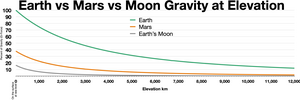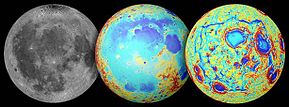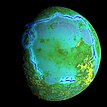사용자:Aspere/달의 중력


달 표면에서의 중력 가속도는 약 1.625 m/s2로, 지구의 약 16.6%, 0.166 ɡ이다.[1] 표면 전체에서의 중력 가속도 변동치는 약 0.0253 m/s2(중력 가속도의 약 1.6%)이다. 무게는 중력 가속도와 직접적인 관계가 있기 때문에, 달에서는 지구에 비해 물체의 무게가 약 6분의 1(16.6%)만 나간다.
중력장[편집]
달의 중력장은 달을 공전하는 우주선이 중력의 차이로 인해 발생하는 미세한 가속도를 우주선에서 방출한 전파의 도플러 효과로 측정하는 방법을 이용하여 구할 수 있으며, 이를 종합하면 달의 중력이상까지 알아낼 수 있다.
중력장의 차이로 인해 달에서 저궤도 대부분은 불안정하며, 실제 측정 결과 안전하게 유지되는 달 저궤도는 궤도 경사가 27°, 50°, 76°, 86°가 되는 지점밖에 없다.[2] 달의 동주기 자전으로 인해 지구에서 달의 뒷면에 있는 우주선을 직접적으로 추적할 수 없기 때문에, 그레일 탐사선 전까지는 뒷면의 중력장을 측정하지 못하였다.

The missions with accurate Doppler tracking that have been used for deriving gravity fields are in the accompanying table. The table gives the mission spacecraft name, a brief designation, the number of mission spacecraft with accurate tracking, the country of origin, and the time span of the Doppler data. Apollos 15 and 16 released subsatellites. The Kaguya/SELENE mission had tracking between 3 satellites to get far-side tracking. GRAIL had very accurate tracking between 2 spacecraft and tracking from Earth.
| 임무명 | ID | 탐사선 개수 | 국가 | 연도 |
|---|---|---|---|---|
| 루나 오비터 1호 | LO1 | 1 | 1966 | |
| 루나 오비터 2호 | LO2 | 1 | 1966–1967 | |
| 루나 오비터 3호 | LO3 | 1 | 1967 | |
| 루나 오비터 4호 | LO4 | 1 | 1967 | |
| 루나 오비터 5호 | LO5 | 1 | 1967–1968 | |
| 아폴로 15호 소형 인공위성 | A15 | 1 | 1971–1972 | |
| 아폴로 16호 소형 인공위성 | A16 | 1 | 1972 | |
| 클레멘타인 | Cl | 1 | 1994 | |
| 루나 프로스펙터 | LP | 1 | 1998–1999 | |
| 월주회위성 카구야 | K/S | 3 | 2007–2009 | |
| 창어 1호 | Ch1 | 1 | 2007–2009 | |
| 그레일 | G | 2 | 2012 | |
| 창어 5호 T1 | Ch1T1 | 1 | 2015–2018 |
The accompanying table below lists lunar gravity fields. The table lists the designation of the gravity field, the highest degree and order, a list of mission IDs that were analyzed together, and a citation. Mission ID LO includes all 5 Lunar Orbiter missions. The GRAIL fields are very accurate; other missions are not combined with GRAIL.
| Designation | Degree | Mission IDs | Citation |
|---|---|---|---|
| LP165P | 165 | LO A15 A16 Cl LP | [4] |
| GLGM3 | 150 | LO A15 A16 Cl LP | [5] |
| CEGM01 | 50 | Ch 1 | [6] |
| SGM100h | 100 | LO A15 A16 Cl LP K/S | [7] |
| SGM150J | 150 | LO A15 A16 Cl LP K/S | [8] |
| CEGM02 | 100 | LO A15 A16 Cl LP K/S Ch1 | [9] |
| GL0420A | 420 | G | [10] |
| GL0660B | 660 | G | [11] |
| GRGM660PRIM | 660 | G | [12] |
| GL0900D | 900 | G | [13] |
| GRGM900C | 900 | G | [14] |
| GRGM1200A | 1200 | G | [15] |
| CEGM03 | 100 | LO A15 A16 Cl LP Ch1 K/S Ch5T1 | [16] |
A major feature of the Moon's gravitational field is the presence of mascons, which are large positive gravity anomalies associated with some of the giant impact basins. These anomalies significantly influence the orbit of spacecraft around the Moon, and an accurate gravitational model is necessary in the planning of both crewed and uncrewed missions. They were initially discovered by the analysis of Lunar Orbiter tracking data:[17] navigation tests prior to the Apollo program showed positioning errors much larger than mission specifications.
Mascons are in part due to the presence of dense mare basaltic lava flows that fill some of the impact basins.[18] However, lava flows by themselves cannot fully explain the gravitational variations, and uplift of the crust-mantle interface is required as well. Based on Lunar Prospector gravitational models, it has been suggested that some mascons exist that do not show evidence for mare basaltic volcanism.[4] The huge expanse of mare basaltic volcanism associated with Oceanus Procellarum does not cause a positive gravity anomaly. The center of gravity of the Moon does not coincide exactly with its geometric center, but is displaced toward the Earth by about 2 kilometers.[19]
달의 질량[편집]
일반적으로 중력 상수 G는 질량과 중력 상수의 곱인 표준 중력 변수(μ = GM)보다 측정의 정확도가 낮다. 이로 인해 일반적으로 달의 질량을 표시할 때는 곱인 GM 형태로 나타낸다. 그레일 탐사선의 측정 결과, 달에서의 GM = 4902.8001 km3/s2이며,[13][12][20] 이를 통해 구한 달의 질량 M = 7.3458 × 1022 kg이고, 평균 밀도는 3346 kg/m3이다. 달의 GM은 지구의 GM 값의 약 1/81.30057이다.[21]
Theory[편집]
For the lunar gravity field, it is conventional to use an equatorial radius of R = 1738.0 km. The gravity potential is written with a series of spherical harmonic functions Pnm. The gravitational potential V at an external point is conventionally expressed as positive in astronomy and geophysics, but negative in physics. Then, with the former sign,
where r is the radius to an external point with r ≥ R, φ is the latitude of the external point, and λ is the east longitude of the external point. Note that the spherical harmonic functions Pnm can be normalized or unnormalized affecting the gravity coefficients Jn, Cnm, and Snm. Here we will use unnormalized functions and compatible coefficients. The Pn0 are called Legendre polynomials and the Pnm with m≠0 are called the Associated Legendre polynomials, where subscript n is the degree, m is the order, and m ≤ n. The sums start at n = 2. The unnormalized degree-2 functions are
Note that of the three functions, only P20(±1)=1 is finite at the poles. More generally, only Pn0(±1)=1 are finite at the poles.
The gravitational acceleration of vector position r is
where er, eφ, and eλ are unit vectors in the three directions.
Gravity coefficients[편집]
The unnormalized gravity coefficients of degree 2 and 3 that were determined by the GRAIL mission are given in Table 1.[13][12][20] The zero values of C21, S21, and S22 are because a principal axis frame is being used. There are no degree-1 coefficients when the three axes are centered on the center of mass.
| nm | Jn | Cnm | Snm |
|---|---|---|---|
| 20 | 203.3 × 10−6 | — | — |
| 21 | — | 0 | 0 |
| 22 | — | 22.4 × 10−6 | 0 |
| 30 | 8.46 × 10−6 | — | — |
| 31 | — | 28.48 × 10−6 | 5.89 × 10−6 |
| 32 | — | 4.84 × 10−6 | 1.67 × 10−6 |
| 33 | — | 1.71 × 10−6 | −0.25 × 10−6 |
The J2 coefficient for an oblate shape to the gravity field is affected by rotation and solid-body tides whereas C22 is affected by solid-body tides. Both are larger than their equilibrium values showing that the upper layers of the Moon are strong enough to support elastic stress. The C31 coefficient is large.
Simulating lunar gravity[편집]
In January 2022 China was reported by the South China Morning Post to have built a small (60 centimeters in diameter) research facility to simulate low lunar gravity with the help of magnets.[22][23] The facility was reportedly partly inspired by the work of Andre Geim (who later shared the 2010 Nobel Prize in Physics for his research on graphene) and Michael Berry, who both shared the Ig Nobel Prize in Physics in 2000 for the magnetic levitation of a frog.[22][23]
같이 보기[편집]
각주[편집]
- ↑ C. Hirt; W. E. Featherstone (2012). “A 1.5 km-resolution gravity field model of the Moon”. 《Earth and Planetary Science Letters》. 329–330: 22–30. Bibcode:2012E&PSL.329...22H. doi:10.1016/j.epsl.2012.02.012. 2012년 8월 21일에 확인함.
- ↑ Bell, Trudy E. (2006년 11월 6일). Phillips, Tony, 편집. “Bizarre Lunar Orbits”. 《Science@NASA》. NASA. 2017년 9월 8일에 확인함.
- ↑ Lunar Gravity Model 2011 보관됨 2013-01-14 - 웨이백 머신
- ↑ 가 나 A. Konopliv; S. Asmar; E. Carranza; W. Sjogren; D. Yuan (2001). “Recent gravity models as a result of the Lunar Prospector mission”. 《Icarus》 50 (1): 1–18. Bibcode:2001Icar..150....1K. CiteSeerX 10.1.1.18.1930. doi:10.1006/icar.2000.6573.
- ↑ Mazarico, E.; Lemoine, F. G.; Han, Shin-Chan; Smith, D. E. (2010). “GLGM-3: A degree-150 lunar gravity model from the historical tracking data of NASA Moon orbiters”. 《Journal of Geophysical Research》 (영어) 115 (E5): E05001, 1–14. Bibcode:2010JGRE..115.5001M. doi:10.1029/2009JE003472. ISSN 0148-0227.
- ↑ Jianguo, Yan; Jinsong, Ping; Fei, Li; Jianfeng, Cao; Qian, Huang; Lihe, Fung (2010). “Chang'E-1 precision orbit determination and lunar gravity field solution”. 《Advances in Space Research》 (영어) 46 (1): 50–57. Bibcode:2010AdSpR..46...50J. doi:10.1016/j.asr.2010.03.002.
- ↑ Matsumoto, K.; Goossens, S.; Ishihara, Y.; Liu, Q.; Kikuchi, F.; Iwata, T.; Namiki, N.; Noda, H.; Hanada, H.; 외. (2010). “An improved lunar gravity field model from SELENE and historical tracking data: Revealing the farside gravity features”. 《Journal of Geophysical Research》 (영어) 115 (E6): E06007, 1–20. Bibcode:2010JGRE..115.6007M. doi:10.1029/2009JE003499. ISSN 0148-0227.
- ↑ Mazarico, E.; Lemoine, F. G.; Han, Shin-Chan; Smith, D. E. (2010). “GLGM-3: A degree-150 lunar gravity model from the historical tracking data of NASA Moon orbiters”. 《Journal of Geophysical Research》 (영어) 115 (E5): E05001, 1–14. Bibcode:2010JGRE..115.5001M. doi:10.1029/2009JE003472. ISSN 0148-0227.
- ↑ Yan, Jianguo; Goossens, Sander; Matsumoto, Koji; Ping, Jinsong; Harada, Yuji; Iwata, Takahiro; Namiki, Noriyuki; Li, Fei; Tang, Geshi; 외. (2012). “CEGM02: An improved lunar gravity model using Chang'E-1 orbital tracking data”. 《Planetary and Space Science》 (영어) 62 (1): 1–9. Bibcode:2012P&SS...62....1Y. doi:10.1016/j.pss.2011.11.010.
- ↑ Zuber, M. T.; Smith, D. E.; Neumann, G. A.; Goossens, S.; Andrews-Hanna, J. C.; Head, J. W.; Kiefer, W. S.; Asmar, S. W.; Konopliv, A. S.; 외. (2016). “Gravity field of the Orientale basin from the Gravity Recovery and Interior Laboratory Mission”. 《Science》 (영어) 354 (6311): 438–441. Bibcode:2016Sci...354..438Z. doi:10.1126/science.aag0519. ISSN 0036-8075. PMC 7462089. PMID 27789835.
- ↑ Konopliv, Alex S.; Park, Ryan S.; Yuan, Dah-Ning; Asmar, Sami W.; Watkins, Michael M.; Williams, James G.; Fahnestock, Eugene; Kruizinga, Gerhard; Paik, Meegyeong; 외. (2013). “The JPL lunar gravity field to spherical harmonic degree 660 from the GRAIL Primary Mission”. 《Journal of Geophysical Research: Planets》 (영어) 118 (7): 1415–1434. Bibcode:2013JGRE..118.1415K. doi:10.1002/jgre.20097. hdl:1721.1/85858. S2CID 16559256.
- ↑ 가 나 다 Lemoine, Frank G.; Goossens, Sander; Sabaka, Terence J.; Nicholas, Joseph B.; Mazarico, Erwan; Rowlands, David D.; Loomis, Bryant D.; Chinn, Douglas S.; Caprette, Douglas S.; Neumann, Gregory A.; Smith, David E. (2013). “High‒degree gravity models from GRAIL primary mission data”. 《Journal of Geophysical Research: Planets》 (영어) 118 (8): 1676–1698. Bibcode:2013JGRE..118.1676L. doi:10.1002/jgre.20118. hdl:2060/20140010292. ISSN 2169-9097.
- ↑ 가 나 다 Konopliv, Alex S.; Park, Ryan S.; Yuan, Dah-Ning; Asmar, Sami W.; Watkins, Michael M.; Williams, James G.; Fahnestock, Eugene; Kruizinga, Gerhard; Paik, Meegyeong; Strekalov, Dmitry; Harvey, Nate (2014). “High-resolution lunar gravity fields from the GRAIL Primary and Extended Missions”. 《Geophysical Research Letters》 (영어) 41 (5): 1452–1458. Bibcode:2014GeoRL..41.1452K. doi:10.1002/2013GL059066.
- ↑ Lemoine, Frank G.; Goossens, Sander; Sabaka, Terence J.; Nicholas, Joseph B.; Mazarico, Erwan; Rowlands, David D.; Loomis, Bryant D.; Chinn, Douglas S.; Neumann, Gregory A.; Smith, David E.; Zuber, Maria T. (2014). “GRGM900C: A degree 900 lunar gravity model from GRAIL primary and extended mission data”. 《Geophysical Research Letters》 (영어) 41 (10): 3382–3389. Bibcode:2014GeoRL..41.3382L. doi:10.1002/2014GL060027. ISSN 0094-8276. PMC 4459205. PMID 26074638.
- ↑ Goossens, Sander; et, al. (2016). “A global degree and order 1200 model of the lunar gravity field using GRAIL mission data” (PDF).
- ↑ Yan, Jianguo; Liu, Shanhong; Xiao, Chi; Ye, Mao; Cao, Jianfeng; Harada, Yuji; Li, Fei; Li, Xie; Barriot, Jean-Pierre (2020). “A degree-100 lunar gravity model from the Chang'e 5T1 mission”. 《Astronomy & Astrophysics》 636: A45, 1–11. Bibcode:2020A&A...636A..45Y. doi:10.1051/0004-6361/201936802. ISSN 0004-6361. S2CID 216482920.
- ↑ P. Muller; W. Sjogren (1968). “Mascons: Lunar mass concentrations”. 《Science》 161 (3842): 680–84. Bibcode:1968Sci...161..680M. doi:10.1126/science.161.3842.680. PMID 17801458. S2CID 40110502.
- ↑ Richard A. Kerr (2013년 4월 12일). “The Mystery of Our Moon's Gravitational Bumps Solved?”. 《Science》 340 (6129): 138–39. doi:10.1126/science.340.6129.138-a. PMID 23580504.
- ↑ Nine Planets
- ↑ 가 나 Williams, James G.; Konopliv, Alexander S.; Boggs, Dale H.; Park, Ryan S.; Yuan, Dah-Ning; Lemoine, Frank G.; Goossens, Sander; Mazarico, Erwan; Nimmo, Francis; Weber, Renee C.; Asmar, Sami W. (2014). “Lunar interior properties from the GRAIL mission”. 《Journal of Geophysical Research: Planets》 (영어) 119 (7): 1546–1578. Bibcode:2014JGRE..119.1546W. doi:10.1002/2013JE004559. S2CID 7045590.
- ↑ Park, Ryan S.; Folkner, William M.; Williams, James G.; Boggs, Dale H. (2021). “The JPL Planetary and Lunar Ephemerides DE440 and DE441”. 《The Astronomical Journal》 (영어) 161 (3): 105. Bibcode:2021AJ....161..105P. doi:10.3847/1538-3881/abd414. ISSN 1538-3881. S2CID 233943954.
- ↑ 가 나 “China building "Artificial Moon" that simulates low gravity with magnets”. 《Futurism.com》. Recurrent Ventures. 2022년 1월 17일에 확인함.
Interestingly, the facility was partly inspired by previous research conducted by Russian physicist Andrew Geim in which he floated a frog with a magnet. The experiment earned Geim the Ig Nobel Prize in Physics, a satirical award given to unusual scientific research. It’s cool that a quirky experiment involving floating a frog could lead to something approaching an honest-to-God antigravity chamber.
- ↑ 가 나 Stephen Chen (2022년 1월 12일). “China has built an artificial moon that simulates low-gravity conditions on Earth”. South China Morning Post. 2022년 1월 17일에 확인함.
It is said to be the first of its kind and could play a key role in the country’s future lunar missions. Landscape is supported by a magnetic field and was inspired by experiments to levitate a frog.




![{\displaystyle V=\left({\frac {GM}{r}}\right)-\left({\frac {GM}{r}}\right)\sum \left({\frac {R}{r}}\right)^{n}J_{n}P_{n,0}(\sin \phi )+\left({\frac {GM}{r}}\right)\sum \left({\frac {R}{r}}\right)^{n}[C_{n,m}P_{n,m}(\sin \phi )\cos(m\lambda )+S_{n,m}P_{n,m}(\sin \phi )\sin(m\lambda )]}](https://wikimedia.org/api/rest_v1/media/math/render/svg/bb4e57eaed82bfc3d5bfa628e063fe3d965f99a1)
![{\displaystyle {\begin{aligned}P_{2,0}&={\frac {3}{2}}\sin ^{2}\!\phi -{\frac {1}{2}}\\[1ex]P_{2,1}&=3\sin \phi \cos \phi \\[1ex]P_{2,2}&=3\cos ^{2}\phi \end{aligned}}}](https://wikimedia.org/api/rest_v1/media/math/render/svg/9efdca9b526b8464ba88ed5603edd93e29b6f804)
![{\displaystyle {\begin{aligned}{\frac {d^{2}r}{dt^{2}}}&=\nabla V\\[1ex]&={\partial V \over \partial r}e_{r}+{\frac {1}{r}}{\partial V \over \partial \phi }e_{\phi }+{\frac {1}{r\cos \phi }}{\partial V \over \partial \lambda }{e_{\lambda }}\end{aligned}}}](https://wikimedia.org/api/rest_v1/media/math/render/svg/054d8a6bb16f2bba5470889b0a9afab61b01605f)
